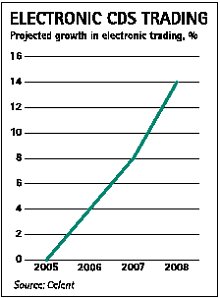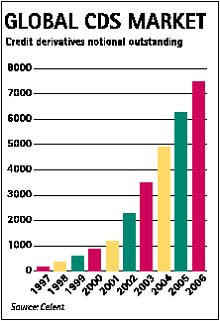Banks are facing growing competition from other financial services firms in the credit derivatives market. Rekha Menon finds they are relying on technological innovation to give them the upper hand.
In the complex world of derivatives trading, the credit derivatives market is growing at a rapid pace, fuelled primarily by an increased emphasis on risk mitigation and the need for instruments to effectively manage credit risk in the face of falling corporate credit quality. According to analyst Celent, the credit derivatives market has grown from a virtual non-entity to a notional outstanding value of more than $2000bn in a decade. Celent expects it to be worth more than $7000bn notional outstanding by 2006. And according to a survey by the International Swaps and Dealers Association (ISDA) at the end of 2003, credit derivatives grew at a stronger rate in the second half (33%) than in the first (25%), and stood valued at $3580bn at the year-end, representing a year-on-year growth of 67%. Competition grows Reflecting this growth, a wide range of firms has started operating in the sector. While banks still account for a majority of credit derivatives trading activity – with the top 10 global banks among the prime movers – new players such as insurance companies, hedge funds and pension funds are slowly increasing their market share. In the face of growing competition, banks are increasingly looking to technology to help them stay ahead. “Fuelled by continuous innovation, credit derivatives are the most dynamic instruments in finance and banks are seeing significant profitability in this area,” says Charles Marston, CEO at Calypso, a credit derivatives technology provider. “The market has grown so rapidly and to such volumes that existing systems have come under strain and market players are recognising the need for trading technology specifically designed to support these complex products.” “In the last three years, we have seen a huge explosion in the credit derivatives space,” says Ciaran Henry, chief technology officer at JPMorgan’s global credit business. “To meet the true growth potential of the business today, we are in the process of transforming our credit-trading platform. We are enhancing the trade capture features, streamlining P&L, working towards greater automation of trade matching and settlement with the Depository Trust & Clearing Corporation (DTCC), and creating an infrastructure to manage hybrid products.” JPMorgan is one of the leading players dominating the trading of credit derivatives. In 2002, the firm handled 26% of the world’s credit derivative trade by banks, followed by Citigroup, which had a 10% share and UBS, with 9%. New trading solutions Like most top-tier banks, all of JPMorgan’s derivatives trading activity has been done by the bank’s proprietary technology platform. But that is changing. The bank has already selected a core credit derivatives vendor solution that will be supported by JPMorgan’s proprietary technology tools and platforms and is in the process of implementing it. Mr Henry has declined to name the selected vendor, pointing out that since it was impossible for a business of JPMorgan’s scale to be solely based on a vendor solution, the bank has decided to go for a mix of vendor and proprietary solutions. “For Tier 1 banks, their key differentiator is their own analytics and risk management tools, for which they usually do not rely on any vendor solution,” says Guillaume Aubert, director of business development at Summit Systems in the US. A leading vendor of trading and risk management platforms, Summit was among the first few vendors to develop a credit derivatives solution about four years ago and recently signed up Bank of Ireland. Off-the-shelf solutions Industry observers have often been very critical of vendor solutions in the credit derivatives space, arguing that they tend to lag behind the market. This observation has been quite accurate – most new products and other developments have originated from the top-tier banks that have the highest momentum in credit derivatives trading. And their trading platforms are based on proprietary technology. Vendors have therefore tended to follow these market leaders. However, JPMorgan’s decision to implement an off-the-shelf solution marks the coming of age of vendor solutions in the credit derivatives space. “Vendors have done a good job of following the market trends. Especially in the flow, credit default swaps (CDS) area, vendor solutions are very good,” says Mr Henry. Vendor solutions have come a long way. Two years ago, when HSBC was looking for a replacement for its derivatives trading platform, Summit, there was no viable credit derivatives solution in the market. “We had two options: to build a system from scratch or to buy an ‘open-box solution’ that could be customised to our requirements,” says Julian Ku, senior vice-president and manager of credit derivatives product at HSBC’s New York office. HSBC finally selected Calypso’s derivatives platform with its Java-based architecture and strong processing power. At that time, Calypso did not have a credit derivatives module. It turned out to be a win-win decision for both the bank and the vendor. Calypso got the requisite fillip to develop a credit derivatives solution in conjunction with a leading bank and HSBC got the opportunity to design its own credit derivatives offering. Key market driver “The development of credit derivatives trading platforms has been an integral part of the growth of the credit derivatives market. These initiatives add to the transparency and availability of credit derivatives pricing and assist liquidity, all of which enhances the efficiency of the market,” says Bob Pickel, CEO and executive director of ISDA. ISDA has played an extremely important role in bringing about standardisation in the credit derivatives space. The credit derivatives market took off in 1999, when ISDA first promulgated credit derivative definitions to standardise contracts and make them more transparent. To further streamline the credit derivatives market, ISDA has exerted efforts to develop automation and straight-through processing (STP) and improve operational excellence through the use of advanced messaging technology, such as Financial Products Markup Language (FpML) along with the DTCC and Swapswire on the operational side. But achieving STP is not that simple. While financial institutions try to implement front-to-back trading platforms that promise a seamless flow of trades, an important element that is often missed in the equation is counterparty automation. One of the biggest challenges to achieving STP in the credit derivatives business is the differing technical capabilities of the counterparties, says Mr Henry. “ Not all of the counterparties can keep up with automation. A lot of investment is required and with a number of hedge funds coming into this space, they might not have the technical and financial resources available,” he says. Adam Josephson, analyst at Celent is optimistic, though. “The industry is rapidly becoming standardised and automated. It has set a number of ambitious deadlines for 2005 with regard to bringing automation and STP to the derivatives space. And these appear likely to be met,” he says. “Standardisation and automation are critical for the credit derivatives market becoming electronic. While both have been slow in coming, market participants appear to be making significant progress and there is a slow but sure move to the electronic medium.” The latest buzz Electronic trading is undoubtedly the latest buzz in the credit derivatives marketplace. In February, the inter-dealer broker Creditex launched an electronic trading platform for credit indices and has since garnered nearly 20% of the index trading market. Creditex launched a similar platform in the late 1990s but it did not take off. The market was not liquid or standardised enough and the platform was more difficult to use.
This time around, Creditex’s timing and offering seems to be spot on. “The Creditex electronic trading platform is popular among dealers, who rate it highly in terms of use and simplicity,” says Mr Josephson. “And, more importantly, the credit index is a product particularly conducive to electronic trading.” He does not see significant liquidity yet in the CDS market and does not foresee CDSs being traded electronically before 2006. Trading platform vendors like Front Capital Systems, an operating unit of SunGard Data Systems, are also viewing the rise of electronic trading favourably. “Electronic trading is a very positive development in the credit derivatives arena. It will facilitate liquidity and transparency in the market. I strongly believe that some exchanges like EUREX, CBOT and LIFFE will soon start offering electronic trading on credit derivatives,” says John Mooren, head of credit derivatives at Front Capital Systems. But he says he believes that a number of banks that trade in the CDS market by phone will find it difficult to move to the electronic medium. And this is where the Front Arena platform can help out, he says. “We have a legacy in electronic trading and our solution can easily link up to the exchanges, which will greatly benefit our customer banks.” High innovation The credit derivative market is an exciting place. Although still in its infancy, the rate of innovation is high, as is the growth and associated opportunities.
Mr Josephson says: “The credit derivatives market will follow in the footsteps of other fixed income markets. In the late 1990s, many thought technology would create a revolution in fixed-income trading. Fixed income markets have been electronic for five years or so and in most, there is a 10%-15% electronic penetration, with plenty of room for growth. By the end of the decade, the credit derivatives market is likely to be where most of the fixed income markets are now.”




